

Defining Transliteracy For Librarians. I have been asked this question many times by librarians so I am way overdue for this post.
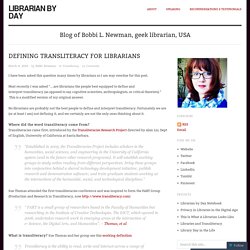
Most recently I was asked “….are librarians the people best equipped to define and interpret transliteracy (as opposed to say cognitive scientists, anthropologists, or critical theorists).” This is a modified version of my original answer. No librarians are probably not the best people to define and interpret transliteracy. Fortunately we are (or at least I am) not defining it, and we certainly are not the only ones thinking about it. Where did the word transliteracy come from? “Established in 2005, the Transliteracies Project includes scholars in the humanities, social sciences, and engineering in the University of California system (and in the future other research programs). Sue Thomas attended the first transliteracies conference and was inspired to form the PART Group (Production and Research in Transliteracy, now What is transliteracy? Is transliteracy new? Probably. References: Like this: Every Platform Tells a Story: Transmedia has the power to make any topic more vivid and personal.
By Peter Gutierrez When Andy Plemmons, a progressive media specialist at David C.
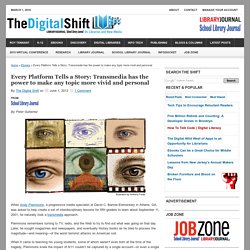
Barrow Elementary in Athens, GA, was asked to help create a set of interdisciplinary lessons for fifth graders to learn about September 11, 2001, he naturally took a transmedia approach. Plemmons remembers turning to TV, radio, and the Web to try to find out what was going on that day. Later, he sought magazines and newspapers, and eventually history books as he tried to process the magnitude—and meaning—of the worst terrorist attacks on American soil. When it came to teaching his young students, some of whom weren’t even born at the time of the tragedy, Plemmons knew the impact of 9/11 couldn’t be captured by a single account—or even a single medium. Many Ways to Tell a Story: How Transmedia Is Transforming Education In and Out of Classrooms. For one language arts class project, a middle school teacher in Shelburne, Virginia, Chad Sansing, asks his sixth graders to read Peter Cherches’s 1986 poem “Lift Your Right Arm,” and then translate it into computer code.
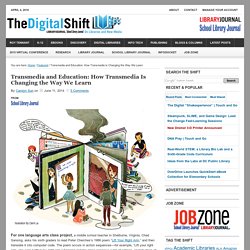
The poem occurs in action sequences—for example, “Lift your right arm, she said. /I lifted my right arm.” 6 Tips to a Super Twitter Profile. After re-vamping my blog header (Teaching Good: Branding Evil) I took a serious look at my professional Twitter profile and changed it, too!
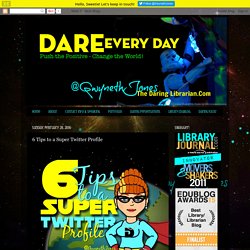
Though, I admit - I'm still not used to it but I'm giving it a whirl! Besides, it's good to practice what I preach. One of the presentations I do when I'm a keynote or a spotlight at conferences is Tweet Like a Ninja (part of the Ninja series) so I thought I would expand on the 6 tips to a super Twitter professional profile for those who are new to Twitter or have been thinking of a similar re-vamp! Please note my disclaimer below & then here we go! 1. But if you don't have a selfie you don't care for, or you don't want to show your face - go ahead and make an avatar! Technology In Early Childhood - Teaching with Technology in Kindergarten and Pre-school Classrooms. Untitled. As I am starting to think more acutely about methodology issues in communication research as part of my doctoral work, I wanted to share my thoughts on a more unconventional approach to research methods in education and multimedia.
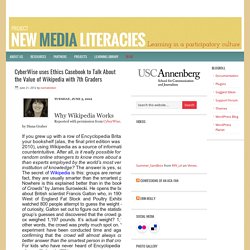
While language-based research methods – both written and oral – have dominated the spectrum of communication research, I am pleased to see that a whole new range of non-textual strategies is gradually emerging as an alternative and highly versatile way of knowing. Specifically, participatory visual communications, such as sketching, photography, and video, hold the inherent potential of painting a more nuanced depiction of lived realities, while simultaneously empowering the study participants, and placing the agency literally in their own hands.
However, perhaps the primary benefit of using visual participatory methods in communication research is their quintessentially inclusive and interactive nature. What Is This Buzz Word “Transliteracy”? A Q&A with Ryan Nadel. 10.25.10 | If you Google “transliteracy,” the definition is nearly unanimous from Wikipedia on down: the ability to read, write and interact on a range of platforms, tools and media.

But, behind the definition, according to Ryan Nadel is a simpler concept that’s as old as the theory of evolution. “The most fundamental notion of transliteracy is the ability to adapt,” says Nadel, founder of 8 Leaf Digital Productions and an instructor at the Vancouver Film School. “It’s creating a literacy and fluidity between mediums that’s not tied to space or modality.” Nadel is one of the authors of a white paper, “Digital Literacy in Canada: From Inclusion to Transformation” calling for federal leadership in creating a national digital literacy strategy to ensure that all Canadians have the necessary skills to use digital technologies to their fullest potential. Nadel talked with Spotlight about how transliteracy and new media technologies are altering our lives.
Ryan Nadel: Definitely. . – Ryan Nadel.